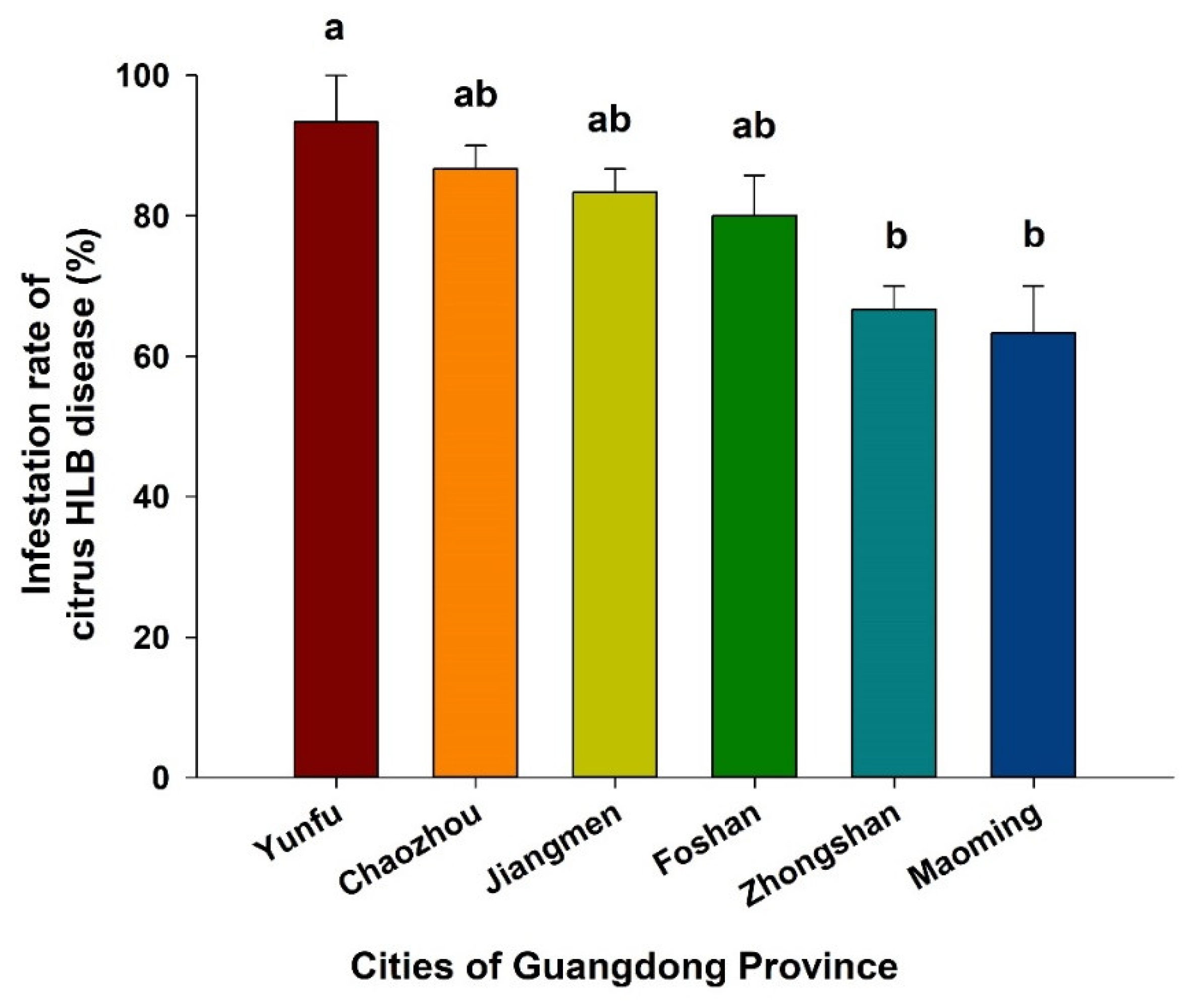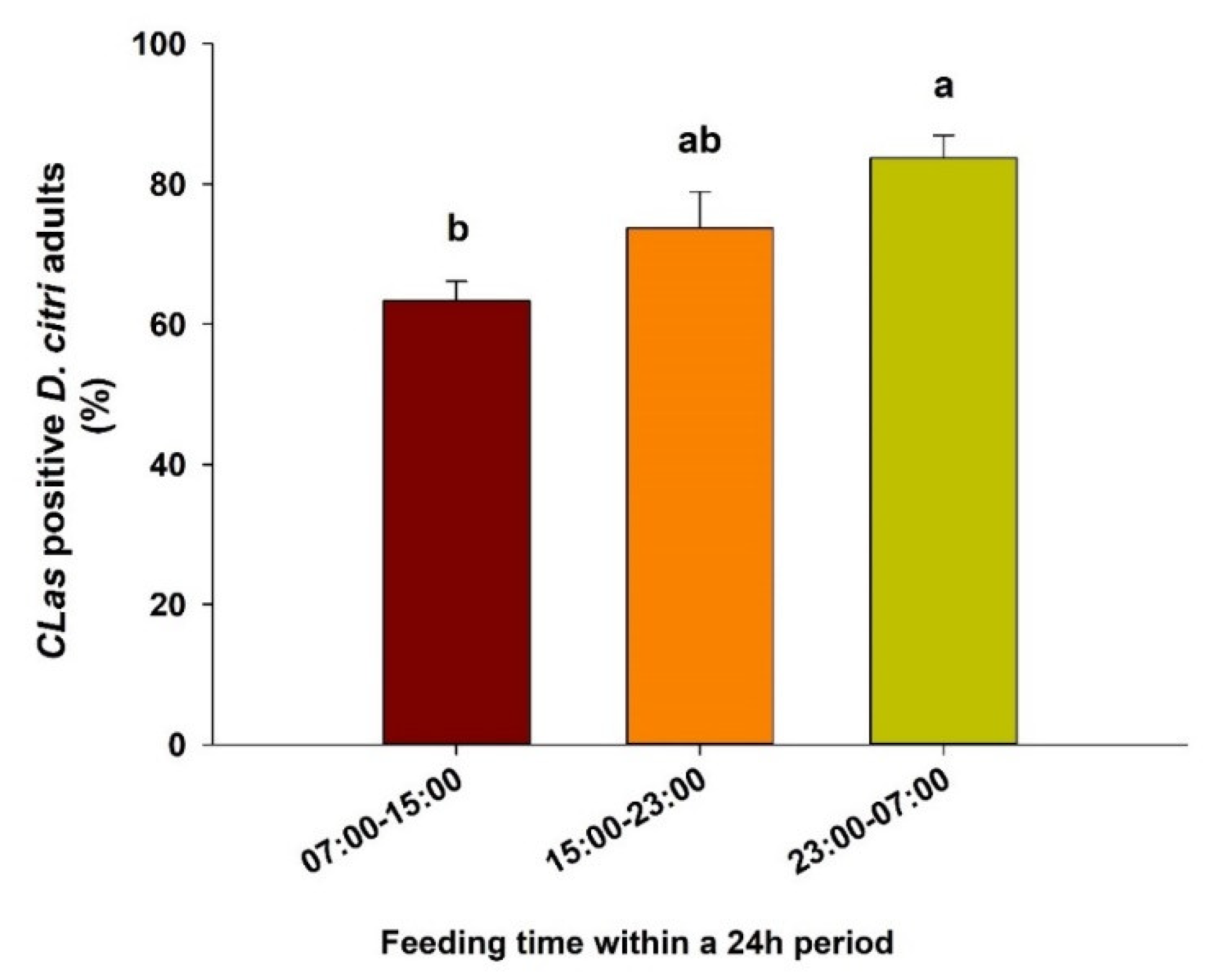Temporal Rhythm Affects the Efficiency of Asian Citrus Psyllid (Diaphorina citri) to Acquire Huanglongbing Pathogen
Abstract
1. Introduction
2. Materials and Methods
2.1. Sample Collection for Citrus Psyllid in Guangdong Province
2.2. Plants and Insects
2.3. The Acquisition Time of CLas by D. citri
2.3.1. Effect of the Feeding Period
2.3.2. Effect of Feeding Time
2.4. Statistical Analysis
3. Results
3.1. Occurrence of CLas-Infected ACP in Guangdong Province
3.2. The Acquisition Time of CLas by D. citri
3.2.1. Effect of Feeding Duration
3.2.2. Acquisition of CLas in Different Time Durations
4. Discussion
5. Conclusions
Author Contributions
Funding
Data Availability Statement
Acknowledgments
Conflicts of Interest
References
- Halbert, S.; Manjunath, K. Asian citrus psyllids (Sternorrhyncha: Psyllidae) and greening disease of citrus: A literature review and assessment of risk in Florida. Florida Entomol. 2004, 87, 330–353. [Google Scholar] [CrossRef]
- Gottwald, T.R. Current epidemiological understanding of citrus huanglongbing. Annu. Rev. Phytopathol. 2010, 48, 119–139. [Google Scholar] [CrossRef] [PubMed]
- Hall, D.G.; Richardson, M.L.; Ammar, E.D.; Halbert, S.E. Asian citrus psyllid, Diaphorina citri, vector of citrus huanglongbing disease. Entomol. Exp. Appl. 2013, 146, 207–223. [Google Scholar] [CrossRef]
- Miyakawa, T. Experimentally induced symptoms and host range of citrus likubin (greening disease). Ann. Phytopathol. Soc. Jpn. 1980, 46, 224–230. [Google Scholar] [CrossRef][Green Version]
- da Graca, J.V. Citrus greening disease. Annu. Rev. Phytopathol. 1991, 29, 109–136. [Google Scholar] [CrossRef]
- Bové, J.M. Huanglongbing: A destructive, newly-emerging, century-old disease of citrus [Asia; South Africa; Brazil; Florida]. J. Plant Pathol. 2006, 88, 7–37. [Google Scholar]
- Garnier, M.; Jagoueix-Eveillard, S.; Cronje, P.R.; Le Roux, H.F.; Bové, J.M. Genomic characterization of a liberibacter present in an ornamental rutaceous tree, Calodendrum capense, in the Western Cape province of South Africa. Proposal of “Candidatus liberibacter africanus subsp. capensis”. Int. J. Syst. Evol. Microbiol. 2000, 50, 2119–2125. [Google Scholar] [CrossRef]
- Sawada, K. Citrus Likubing(pre-report). Taiwan Agric. Rep. 1913, 83, 903–914. [Google Scholar]
- Reinking, O.A. Diseases of economic plants in southern China. Philipp. Agric. 1919, 8, 109–134. [Google Scholar]
- Tyler, H.L.; Roesch, L.F.W.; Gowda, S.; Dawson, W.O.; Triplett, E.W. Confirmation of the sequence of “Candidatus liberibacter asiaticus” and assessment of microbial diversity in huanglongbing-infected citrus phloem using a metagenomic approach. Mol. Plant-Microbe Interact. 2009, 22, 1624–1634. [Google Scholar] [CrossRef][Green Version]
- Aubert, B. Trioza erytreae del Guercio and Diaphorina citri Kuwayama (Homoptera: Psylloidea), the two vectors of citrus greening disease: Biological aspects and possible control strategies. Fruits 1987, 42, 149–162. [Google Scholar]
- Li, Y. Molecular Detection of Endosymbiont in Citrus Psyllid and the Relation between Feeding Time and Efficiency of Bacteria in Citrus Psyllid. Master’s Thesis, South China Agricultural University, Guangzhou, China, 2016. [Google Scholar]
- Hosseinzadeh, S.; Shams-bakhsh, M.; Mann, M.; Fattah-hosseini, S. Distribution and variation of bacterial endosymbiont and “Candidatus Liberibacter asiaticus” titer in the Huanglongbing insect vector, Diaphorina citri Kuwayama. Microb. Ecol. 2019, 78, 206–222. [Google Scholar] [CrossRef]
- Cicero, J.M.; Brown, J.K.; Roberts, P.D.; Stansly, P.A. The digestive system of Diaphorina citri and Bactericera cockerelli (Hemiptera: Psyllidae). Ann. Entomol. Soc. Am. 2009, 102, 650–665. [Google Scholar] [CrossRef]
- Zhang, J.; Li, S.; Li, W.; Chen, Z.; Guo, H.; Liu, J.; Xu, Y.; Xiao, Y.; Zhang, L.; Arunkumar, K.P.; et al. Circadian regulation of night feeding and daytime detoxification in a formidable Asian pest Spodoptera litura. Commun. Biol. 2021, 4, 286. [Google Scholar] [CrossRef]
- Capoor, S.; Rao, G.; Viswanath, S. Greening disease of citrus in the Deccan Trap Country and its relationship with the vector, Diaphorina citri Kuwayama. In Proceedings of the 6th Conference of International Organization of Citrus Virologists, Swaziland, Eswatini, 21–28 August 1972; pp. 43–49. [Google Scholar]
- Hung, T.H.; Hung, S.C.; Chen, C.N.; Hsu, M.H.; Su, H.J. Detection by PCR of Candidatus Liberibacter asiaticus, the bacterium causing citrus huanglongbing in vector psyllids: Application to the study of vector-pathogen relationships. Plant Pathol. 2004, 53, 96–102. [Google Scholar] [CrossRef]
- Brlansky, R.H.; Rogers, M.E.; Alfred, L. Citrus Huanglongbing: Understanding the Vector-Pathogen Interaction for Disease Management. APSnet 2008, 8, 1–9. [Google Scholar] [CrossRef]
- Ammar, E.D.; Shatters, R.G.; Hall, D.G. Localization of Candidatus Liberibacter asiaticus, Associated with Citrus Huanglongbing Disease, in its Psyllid Vector using Fluorescence in situ Hybridization. J. Phytopathol. 2011, 159, 726–734. [Google Scholar] [CrossRef]
- Ammar, E.D.; Shatters, R.G.; Lynch, C.; Hall, D.G. Detection and relative titer of Candidatus liberibacter asiaticus in the salivary glands and alimentary canal of Diaphorina citri (Hemiptera: Psyllidae) vector of citrus huanglongbing disease. Ann. Entomol. Soc. Am. 2011, 104, 526–533. [Google Scholar] [CrossRef]
- Pelz-Stelinski, K.S.; Brlansky, R.H.; Ebert, T.A.; Rogers, M.E. Transmission parameters for Candidatus Liberibacter asiaticus by Asian citrus psyllid (Hemiptera: Psyllidae). J. Econ. Entomol. 2010, 103, 1531–1541. [Google Scholar] [CrossRef] [PubMed]
- Inoue, H.; Ohnishi, J.; Ito, T.; Tomimura, K.; Miyata, S.; Iwanami, T.; Ashihara, W. Enhanced proliferation and efficient transmission of Candidatus Liberibacter asiaticus by adult Diaphorina citri after acquisition feeding in the nymphal stage. Ann. Appl. Biol. 2009, 155, 29–36. [Google Scholar] [CrossRef]
- Lee, A.J.; Halbert, S.E.; Dawson, W.O.; Robertson, C.J.; Keesling, J.E.; Singer, B.H. Asymptomatic spread of huanglongbing and implications for disease control. Proc. Natl. Acad. Sci. USA 2015, 112, 7605–7610. [Google Scholar] [CrossRef]
- Huang, C.; Tsai, Y.; Wang, C. Transmission of citrus likubin by a psyllid, Diaphorina citri. J. Agric. Res. China 1984, 33, 65–72. [Google Scholar]
- Li, C.; Kuang, Y.; Huang, N.; Zhang, C. The long-term relationship between population growth and vegetation cover: An empirical analysis based on the panel data of 21 cities in guangdong province, China. Int. J. Environ. Res. Public Health 2013, 10, 660–677. [Google Scholar] [CrossRef]
- Coy, M.R.; Hoffmann, M.; Kingdom Gibbard, H.N.; Kuhns, E.H.; Pelz-Stelinski, K.S.; Stelinski, L.L. Nested-quantitative PCR approach with improved sensitivity for the detection of low titer levels of Candidatus Liberibacter asiaticus in the Asian citrus psyllid, Diaphorina citri Kuwayama. J. Microbiol. Methods 2014, 102, 15–22. [Google Scholar] [CrossRef]
- Wang, N.; Trivedi, P. Citrus huanglongbing: A newly relevant disease presents unprecedented challenges. Phytopathology 2013, 103, 652–665. [Google Scholar] [CrossRef]
- Johnson, E.G.; Wu, J.; Bright, D.B.; Graham, J.H. Association of “Candidatus Liberibacter asiaticus” root infection, but not phloem plugging with root loss on huanglongbing-affected trees prior to appearance of foliar symptoms. Plant Pathol. 2014, 63, 290–298. [Google Scholar] [CrossRef]
- Zhang, Y.; Xu, J.; Riera, N.; Jin, T.; Li, J.; Wang, N. Huanglongbing impairs the rhizosphere-to-rhizoplane enrichment process of the citrus root-associated microbiome. Microbiome 2017, 5, 97. [Google Scholar] [CrossRef]
- Zhou, C. The status of citrus Huanglongbing in China. Trop. Plant Pathol. 2020, 45, 279–284. [Google Scholar] [CrossRef]
- Deng, X.L.; Gao, Y.D.; Chen, J.C.; Pu, X.L.; Kong, W.W.; Li, H.P. Curent situation of “Candidatus Liberibacter asiaticus” in Guangdong, China, where citrus Huanglongbing was first described. J. Integr. Agric. 2012, 11, 424–429. [Google Scholar] [CrossRef]
- Halbert, S.; Singer, B. Epidemiology of Huanglongbing: Imolication of infective colonization events. In Asian Citrus Psyllid: Biology, Ecology and Management of the Huanglongbing Vector; Qureshi, J.A., Stansly, P.A., Eds.; CABI Publishing: Gainesville, FL, USA, 2020; pp. 140–155. [Google Scholar]
- Mann, R.S.; Ali, J.G.; Hermann, S.L.; Tiwari, S.; Pelz-Stelinski, K.S.; Alborn, H.T.; Stelinski, L.L. Induced release of a plant-defense volatile “deceptively” attracts insect vectors to plants infected with a bacterial pathogen. PLoS Pathog. 2012, 8, e1002610. [Google Scholar] [CrossRef] [PubMed]
- Xu, C.F.; Xia, Y.H.; Li, K.B.; Ke, C. Further study of the transmission of citrus huanglongbing by a psyllid, Diaphorina citri Kuwayama. In Proceedings of the 10th Conference of the International Organization of Citrus Virologists, Valencia, Spain, 17–21 November 1986; pp. 243–248. [Google Scholar]
- Ying, B.; Liu, H.; Tsai, J.H. Effects of temperature on biology and life table parameters of the Asian citrus psyllid, Diaphorina citri Kuwayama (Homoptera: Psyllidae). Annu. Appl. Biol. 2000, 137, 201–206. [Google Scholar]
- Suszczynska, A.; Kaniewska, M.M.; Bebas, P.; Giebultowicz, J.M.; Kotwica-Rolinska, J. Circadian regulation of caterpillar feeding and growth. J. Insect Physiol. 2017, 101, 113–122. [Google Scholar] [CrossRef]
- Niepoth, N.; Ke, G.; de Roode, J.C.; Groot, A.T. Comparing Behavior and Clock Gene Expression between Caterpillars, Butterflies, and Moths. J. Biol. Rhythm. 2018, 33, 52–64. [Google Scholar] [CrossRef]
- Moll, J.N.; Van Vuuren, S.P. Greening disease in Africa. In Proceedings of the International Society of Citriculture, Orlando, FL, USA, 1–8 May 1977; pp. 903–912. [Google Scholar]
- Nalam, V.; Isaacs, T.; Moh, S.; Kansman, J.; Finke, D.; Albrecht, T.; Nachappa, P. Diurnal feeding as a potential mechanism of osmoregulation in aphids. Insect Sci. 2021, 28, 521–532. [Google Scholar] [CrossRef]
- Chiel, E.; Messika, Y.; Steinberg, S. The effect of UV-absorbing plastic sheet on the attraction and host location ability of three parasitoids: Aphidius colemani, Diglyphus isaea and Eretmocerus mundus. BioControl 2006, 51, 65–78. [Google Scholar] [CrossRef]
- Doukas, D.; Payne, C.C. Effects of UV-blocking films on the dispersal behaviour of Encarsia formosa (Hymenoptera: Aphelinidae). J. Econ. Entomol. 2007, 100, 110–116. [Google Scholar] [CrossRef]
- Doukas, D.; Payne, C.C. Greenhouse whitefly (Homoptera: Aleyrodidae) dispersal under different UV-light environments. J. Econ. Entomol. 2007, 100, 389–397. [Google Scholar] [CrossRef] [PubMed]
- Doukas, D.; Payne, C.C. The use of ultraviolet-blocking films in insect pest management in the UK; effects on naturally occurring arthropod pest and natural enemy populations in a protected cucumber crop. Ann. Appl. Biol. 2007, 151, 221–231. [Google Scholar] [CrossRef]
- El-aal, H.A.A.; Rizk, A.M.; Mousa, I.E. Evaluation of new greenhouse covers with modi fi ed light regime to control cotton aphid and cucumber (Cucumis sativus L.) productivity. Crop Prot. 2018, 107, 64–70. [Google Scholar] [CrossRef]




Publisher’s Note: MDPI stays neutral with regard to jurisdictional claims in published maps and institutional affiliations. |
© 2021 by the authors. Licensee MDPI, Basel, Switzerland. This article is an open access article distributed under the terms and conditions of the Creative Commons Attribution (CC BY) license (https://creativecommons.org/licenses/by/4.0/).
Share and Cite
Guo, Y.-J.; Li, Y.-H.; Su, Z.-Q.; Xu, P.-P.; Qiu, B.-L.; Ji, Q.-H.; Khan, M.M. Temporal Rhythm Affects the Efficiency of Asian Citrus Psyllid (Diaphorina citri) to Acquire Huanglongbing Pathogen. Agronomy 2021, 11, 1956. https://doi.org/10.3390/agronomy11101956
Guo Y-J, Li Y-H, Su Z-Q, Xu P-P, Qiu B-L, Ji Q-H, Khan MM. Temporal Rhythm Affects the Efficiency of Asian Citrus Psyllid (Diaphorina citri) to Acquire Huanglongbing Pathogen. Agronomy. 2021; 11(10):1956. https://doi.org/10.3390/agronomy11101956
Chicago/Turabian StyleGuo, Yan-Jun, Yi-Han Li, Zheng-Qin Su, Pei-Ping Xu, Bao-Li Qiu, Qian-Hua Ji, and Muhammad Musa Khan. 2021. "Temporal Rhythm Affects the Efficiency of Asian Citrus Psyllid (Diaphorina citri) to Acquire Huanglongbing Pathogen" Agronomy 11, no. 10: 1956. https://doi.org/10.3390/agronomy11101956
APA StyleGuo, Y.-J., Li, Y.-H., Su, Z.-Q., Xu, P.-P., Qiu, B.-L., Ji, Q.-H., & Khan, M. M. (2021). Temporal Rhythm Affects the Efficiency of Asian Citrus Psyllid (Diaphorina citri) to Acquire Huanglongbing Pathogen. Agronomy, 11(10), 1956. https://doi.org/10.3390/agronomy11101956





